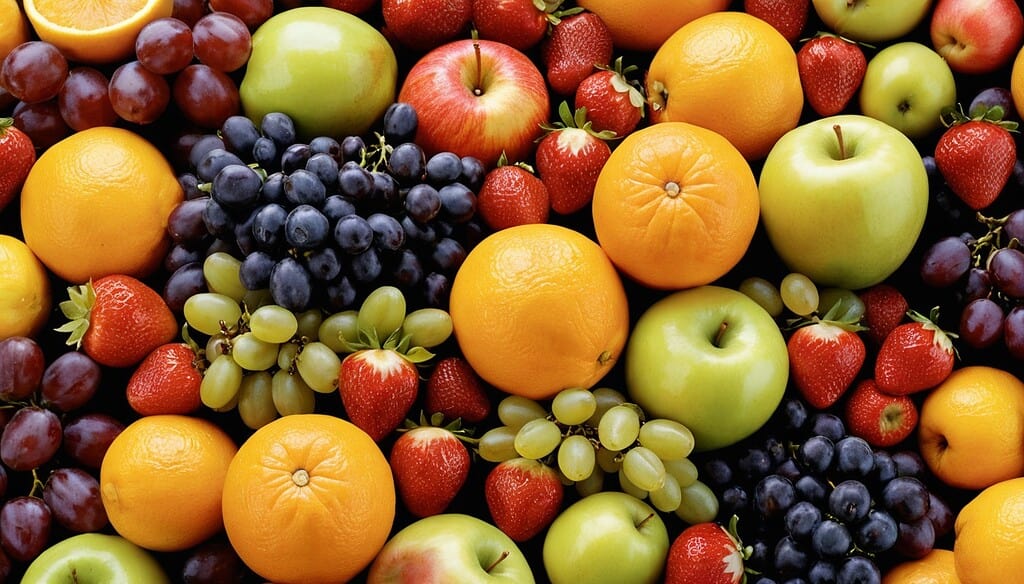Table of Contents
Introduction: Exploring the World of Fruit Families
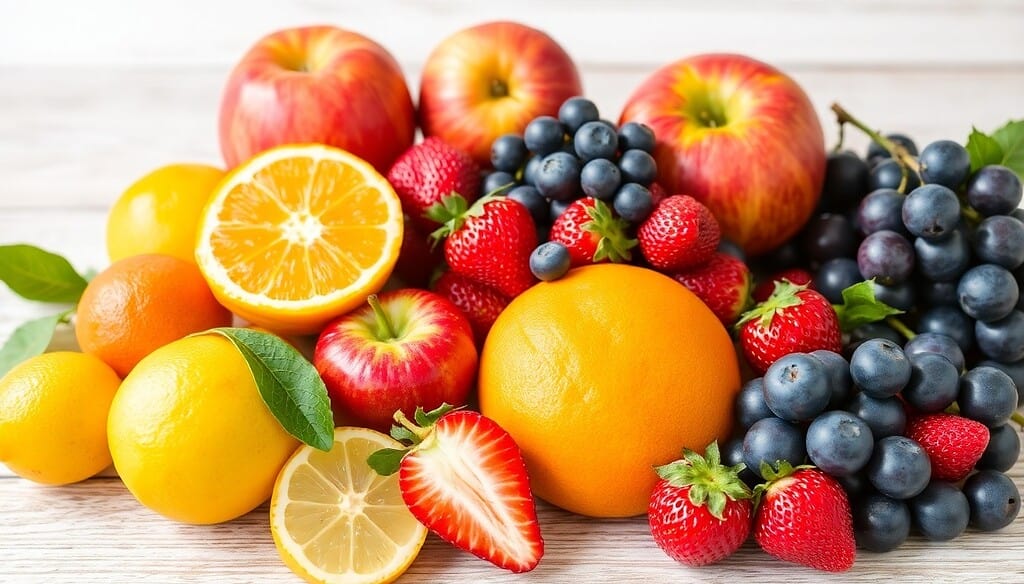
Nature organized fruits into distinct botanical dynasties millions of years ago. These fruit families exemplify evolutionary achievements that have influenced human nutrition throughout various continents and cultures. Each family carries unique genetic blueprints that determine their nutritional profiles, medicinal properties, and survival strategies.
Scientists classify fruits based on their flower structures, seed arrangements, and genetic relationships rather than their appearance or taste. This classification reveals fascinating connections between seemingly different foods. A cherry shares more genetic material with an apple than with a grape, despite looking nothing alike.
The evolution of Fruit Families mirrors human civilization itself. Ancient trade routes carried citrus fruits from Asia to Europe. Mediterranean cultures built entire cuisines around grape cultivation. Indigenous peoples of the Americas developed sophisticated agricultural systems centered on gourd families.
Modern nutritional science confirms what traditional cultures knew instinctively. Different Fruit Families offer complementary health benefits that work synergistically in human diets. Understanding these relationships helps us make informed choices about the foods we eat daily.
Global Distribution of Major Fruit Families by Continent
| Continent | Primary Families | Notable Examples | Cultivation History |
|---|---|---|---|
| Asia | Rutaceae, Rosaceae | Oranges, Apples, Peaches | 4000+ years |
| Europe | Vitaceae, Rosaceae | Grapes, Cherries, Pears | 3000+ years |
| Americas | Solanaceae, Cucurbitaceae | Tomatoes, Pumpkins | 8000+ years |
| Africa | Musaceae, Anacardiaceae | Bananas, Mangoes | 5000+ years |
| Australia | Myrtaceae, Proteaceae | Eucalyptus fruits, Macadamia | 2000+ years |
1. Fruit Families: Rutaceae (Citrus Family) Citrus Power for Immunity
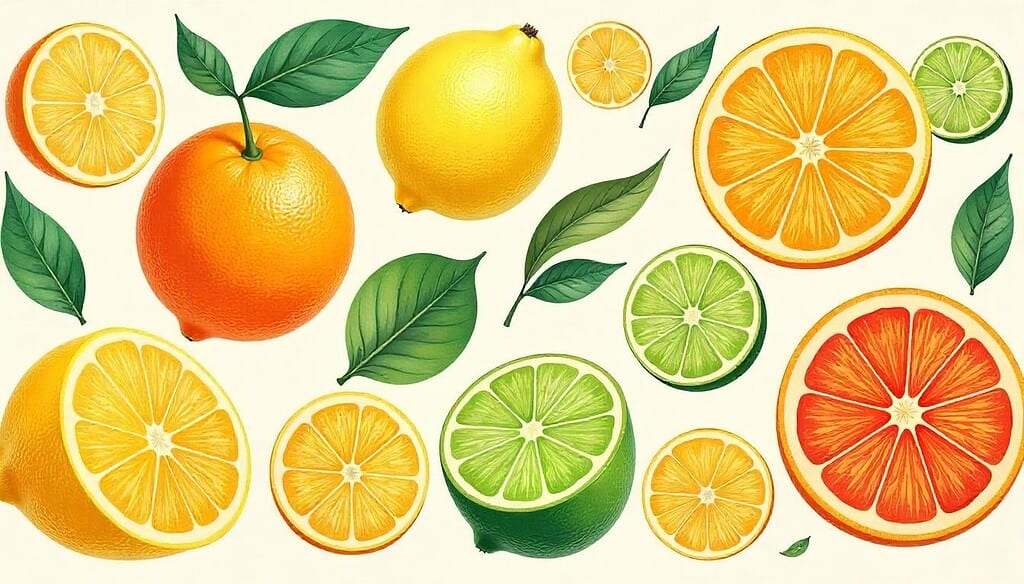
The citrus dynasty emerged in Southeast Asia over 20 million years ago. These Fruit Families developed their characteristic acidic profiles as natural preservatives against bacterial infections. The thick, oil-rich peels protect valuable seeds while providing concentrated nutrients to both plant and consumer.
The elevated levels of Vitamin C found in citrus fruits developed as a means of survival. Wild citrus trees needed powerful antioxidants to thrive in tropical climates with intense ultraviolet radiation. This evolutionary adaptation became humanity’s shield against scurvy during long ocean voyages.
Lemons have a higher concentration of citric acid compared to any other widely consumed fruit. This natural preservative extends the shelf life of foods and enhances iron absorption in human digestion. Mediterranean cultures discovered these properties centuries before modern science explained the mechanisms.
Oranges balance sweetness with nutrition more effectively than most fruits. A single medium orange provides over 100 percent of daily vitamin C requirements while delivering folate, potassium, and fiber. The white pith beneath the peel contains flavonoids that work synergistically with vitamin C.
Limes offer unique nutritional compounds not found in other citrus varieties. Their high citric acid content makes them natural detoxifiers. Traditional medicine systems across tropical regions use lime juice to treat digestive disorders and boost immune function.
Nutritional Profile of Common Citrus Fruits per 100g
| Citrus Fruit | Vitamin C (mg) | Citric Acid (%) | Flavonoids (mg) | Fiber (g) |
|---|---|---|---|---|
| Lemon | 53 | 5.7 | 28 | 2.8 |
| Orange | 53 | 1.0 | 62 | 2.4 |
| Lime | 29 | 8.0 | 22 | 2.8 |
| Grapefruit | 31 | 1.8 | 45 | 1.6 |
| Mandarin | 27 | 0.9 | 34 | 1.8 |
2. Fruit Families: Vitaceae (Grape Family) Fruits and Antioxidant Richness
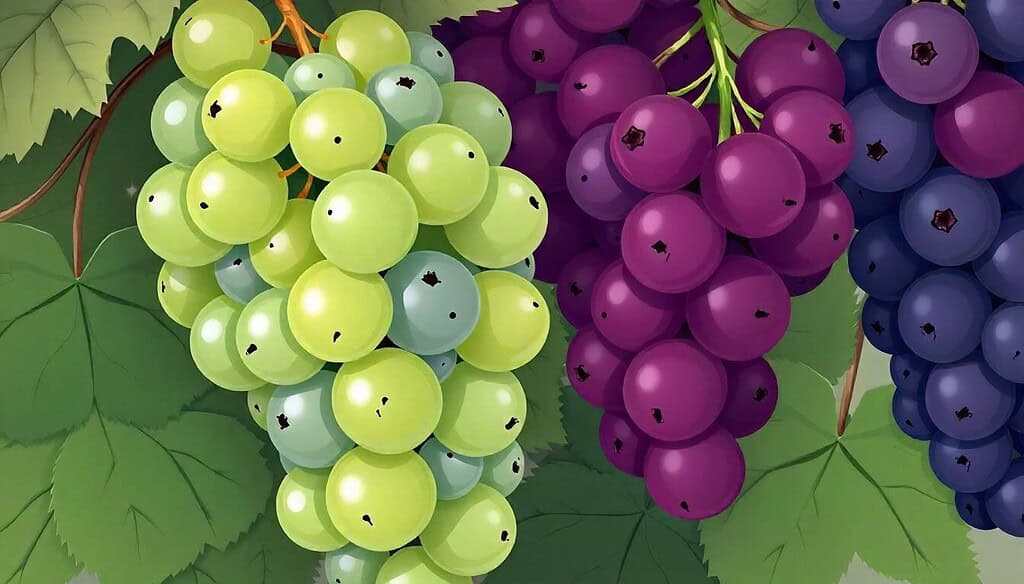
Grapes represent one of humanity’s oldest cultivated Fruit Families. Archaeological evidence shows wine production dating back 8,000 years in the Caucasus region. This ancient relationship between humans and grapes created thousands of varieties adapted to different climates and soils.
The deep purple color of many grapes signals high anthocyanin content. These powerful antioxidants protect cells from oxidative damage and support cardiovascular health. Red wine’s reputation for heart protection stems from these concentrated compounds in grape skins.
Resveratrol concentrates in grape skins as a natural fungicide. This compound protects vines from harmful bacteria and molds. Human studies suggest resveratrol may activate longevity genes and reduce inflammation throughout the body.
White grapes contain different antioxidant profiles than their darker cousins. They emphasize flavonols and phenolic acids that support liver function and blood sugar regulation. The absence of anthocyanins allows other beneficial compounds to dominate.
Grape seeds pack dense nutrition despite their small size. They contain proanthocyanidins, powerful antioxidants that strengthen blood vessel walls and improve circulation. Traditional medicine systems have ground grape seeds into healing powders for centuries.
Antioxidant Content in Different Grape Varieties per 100g
| Grape Variety | Anthocyanins (mg) | Resveratrol (mg) | Flavonols (mg) | ORAC Value |
|---|---|---|---|---|
| Concord (Purple) | 326 | 0.24 | 18 | 739 |
| Cabernet (Red) | 187 | 0.31 | 22 | 542 |
| Pinot Noir (Red) | 245 | 0.42 | 16 | 683 |
| Chardonnay (White) | 0 | 0.09 | 14 | 178 |
| Riesling (White) | 0 | 0.12 | 19 | 201 |
3. Fruit Families: Rosaceae (Rose Family) Fruits – Lineage of Apples and Berries
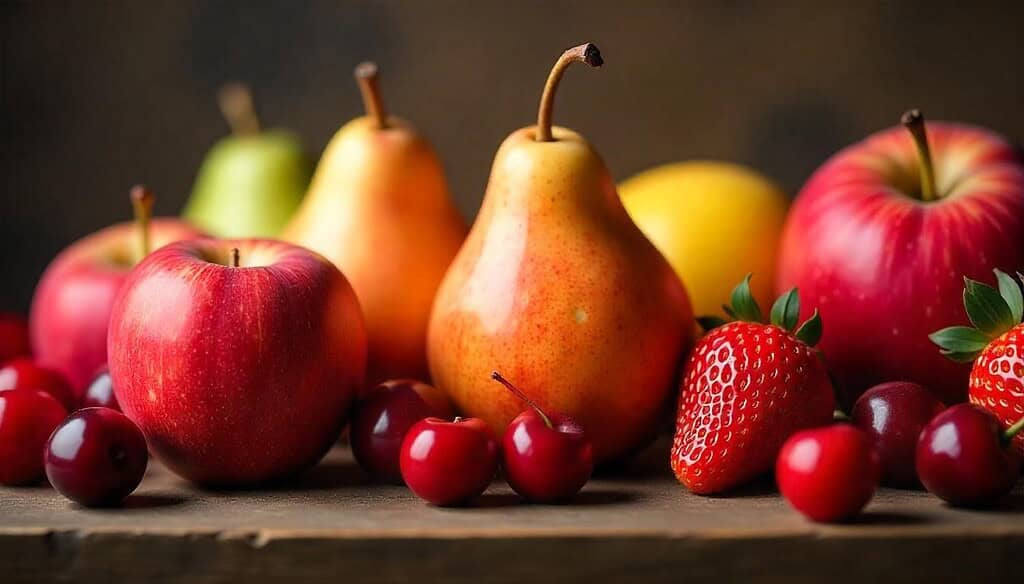
The rose family encompasses more edible fruits than any other botanical group. Apples, pears, cherries, plums, peaches, strawberries, and raspberries all have a shared lineage. This variety illustrates millions of years of adaptation to various environments and pollination methods.
Apples developed their crunchy texture and sweet-tart flavor to entice mammals for seed dispersal. The pectin in apple flesh forms natural gels that slow sugar absorption and feed beneficial gut bacteria. Traditional sayings about apples and health reflect genuine nutritional wisdom.
Cherries concentrate anthocyanins and melatonin in their deep red flesh. These compounds work together to reduce inflammation and regulate sleep cycles. Tart cherries contain higher concentrations than sweet varieties, explaining their use in sports recovery drinks.
Strawberries technically qualify as aggregate fruits with seeds on the outside. Their high vitamin C content rivals citrus fruits, while their low glycemic impact makes them suitable for blood sugar management. The ellagic acid in strawberries shows promise for cancer prevention.
Stone fruits like peaches and plums developed their succulent flesh around hard pits. This evolutionary strategy protects seeds while providing attractive nutrition to animals. The beta-carotene in orange-fleshed varieties supports eye health and immune function.
Fiber and Phytonutrient Content of Rosaceae Fruits per 100g
| Rosaceae Fruit | Total Fiber (g) | Soluble Fiber (g) | Anthocyanins (mg) | Quercetin (mg) |
|---|---|---|---|---|
| Apple | 2.4 | 1.2 | 0 | 4.4 |
| Sweet Cherry | 2.1 | 0.6 | 82 | 1.8 |
| Strawberry | 2.0 | 0.6 | 15 | 2.2 |
| Peach | 1.5 | 0.8 | 0 | 1.1 |
| Raspberry | 6.5 | 1.1 | 365 | 1.9 |
4. Fruit Families: Musaceae (Banana Family) Fruits as Potassium Powerhouses

Bananas originated in Southeast Asia over 10,000 years ago as one of humanity’s first cultivated crops. These Fruit Families have disseminated throughout tropical areas as a result of human migration and commerce. Modern bananas descend from ancient varieties that required careful cultivation and propagation techniques.
The potassium content in bananas evolved to support rapid plant growth in tropical climates. This same mineral supports human muscle and nerve function, making bananas popular among athletes. A medium banana provides about 400 milligrams of potassium, roughly 10 percent of daily needs.
Unripe Green bananas possess resistant starch that nourishes advantageous gut bacteria. As bananas ripen, enzymes convert this starch into simple sugars, changing both flavor and nutritional impact. Traditional cuisines use bananas at different ripeness stages for various culinary and medicinal purposes.
Plantains represent larger, starchier relatives of common bananas. They serve as staple foods across tropical regions, providing steady energy and essential nutrients. When cooked, plantains offer complex carbohydrates that sustain energy levels for hours.
Banana varieties number in the thousands, though commercial cultivation focuses on just a few types. Wild bananas have larger seeds and a lower flesh content compared to cultivated varieties. This genetic diversity becomes crucial for protecting crops against diseases and climate change.
Nutritional Composition of Banana Family Fruits per 100g
| Banana Type | Potassium (mg) | Resistant Starch (g) | Vitamin B6 (mg) | Natural Sugars (g) |
|---|---|---|---|---|
| Green Banana | 358 | 12.5 | 0.4 | 1.2 |
| Ripe Banana | 358 | 0.3 | 0.4 | 17.2 |
| Red Banana | 348 | 1.8 | 0.3 | 16.6 |
| Plantain (Green) | 499 | 15.3 | 0.3 | 1.5 |
| Plantain (Ripe) | 465 | 2.1 | 0.3 | 11.9 |
5. Fruit Families: Anacardiaceae (Cashew Family) Fruits With Energy and Endurance
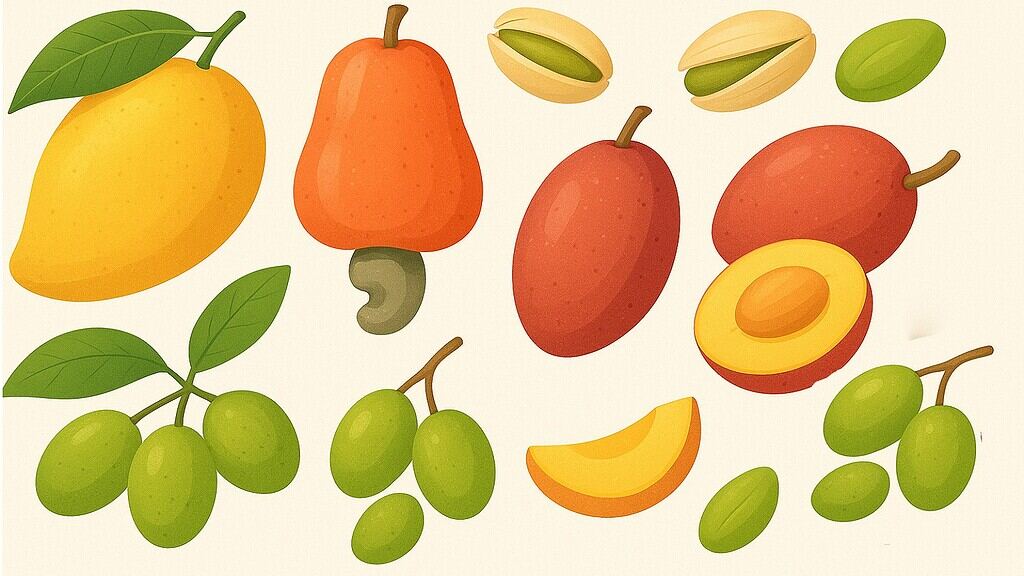
The cashew family produces some of nature’s most energy-dense foods. Mangoes, cashews, and pistachios evolved in different regions but share similar nutritional strategies. These Fruit Families concentrate healthy fats, proteins, and complex carbohydrates that sustained ancient civilizations.
Mangoes originated in South Asia over 4,000 years ago. Their sweet flesh provides beta-carotene, vitamin C, and fiber while their large seeds store energy for new plant growth. Traditional Ayurvedic medicine considers mango to be a cooling food that balances body heat during hot seasons.
Cashews grow in unusual formations with the nut attached beneath the fruit. The cashew apple provides vitamin C and antioxidants, while the nut delivers healthy monounsaturated fats and protein. Processing cashews requires careful handling due to toxic oils in the shell.
Pistachios developed their hard shells as protection against desert conditions. The nuts inside contain complete proteins, healthy fats, and unique antioxidants like lutein and zeaxanthin. These compounds support eye health and may reduce age-related vision problems.
The resinous nature of many Anacardiaceae plants reflects their adaptation to harsh environments. These compounds often provide antimicrobial and anti-inflammatory benefits when consumed. Traditional medicine systems recognized these properties long before scientific analysis.
Energy and Nutrient Density of Anacardiaceae Family Foods per 100g
| Family Member | Calories | Healthy Fats (g) | Protein (g) | Beta-Carotene (μg) |
|---|---|---|---|---|
| Mango | 60 | 0.4 | 0.8 | 640 |
| Cashew Nuts | 553 | 30.2 | 18.2 | 0 |
| Pistachio Nuts | 560 | 28.0 | 20.2 | 332 |
| Cashew Apple | 46 | 0.2 | 1.0 | 54 |
| Pink Peppercorn | 289 | 4.2 | 3.9 | 89 |
6. Fruit Families: Cucurbitaceae (Gourd Family) Fruits as Hydration and Healing Fruits
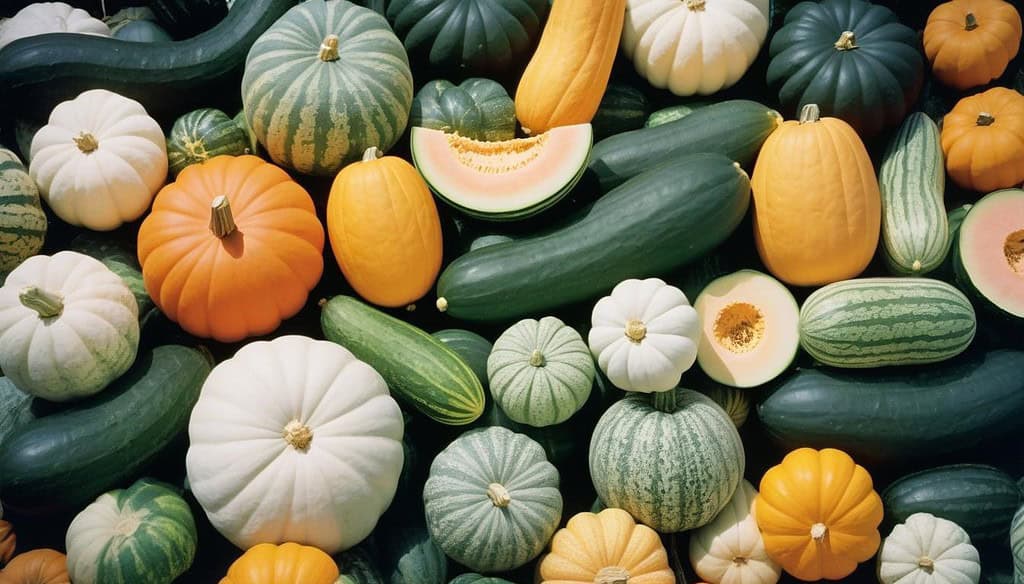
Gourds represent one of humanity’s oldest cultivated Fruit Families. Archaeological evidence shows squash cultivation in the Americas dating back 10,000 years. These versatile plants provided food, water storage, and tools for ancient civilizations across multiple continents.
Watermelons evolved in African deserts, where water conservation meant survival. Their flesh contains over 90 percent water along with electrolytes and lycopene. This combination provides natural hydration while delivering antioxidants that protect against cellular damage.
Cucumbers developed their cooling properties as an adaptation to hot climates. Their high water content and natural compounds create refreshing effects that traditional medicine systems have recognized for centuries. Modern research confirms cucumber’s anti-inflammatory and hydrating benefits.
Pumpkins and winter squashes store dense nutrition in their orange flesh. Beta-carotene concentrations rival those found in carrots, while complex carbohydrates provide sustained energy. The seeds contain zinc, healthy fats, and proteins that complement the flesh’s nutrition.
Melons balance sweetness with hydration more effectively than most fruits. Their natural sugars absorb quickly for energy, while high water content prevents dehydration. Different melon varieties offer unique antioxidant profiles from their colorful flesh.
Water Content and Nutritional Benefits of Cucurbitaceae Fruits per 100g
| Gourd Family Fruit | Water Content (%) | Lycopene (mg) | Beta-Carotene (μg) | Potassium (mg) |
|---|---|---|---|---|
| Watermelon | 91.4 | 4.5 | 303 | 112 |
| Cucumber | 95.2 | 0 | 45 | 147 |
| Cantaloupe | 90.2 | 0 | 2020 | 267 |
| Honeydew | 89.8 | 0 | 50 | 228 |
| Pumpkin | 91.6 | 0 | 3100 | 340 |
7. Fruit Families: Ericaceae (Heath Family) Fruits for Brain and Heart
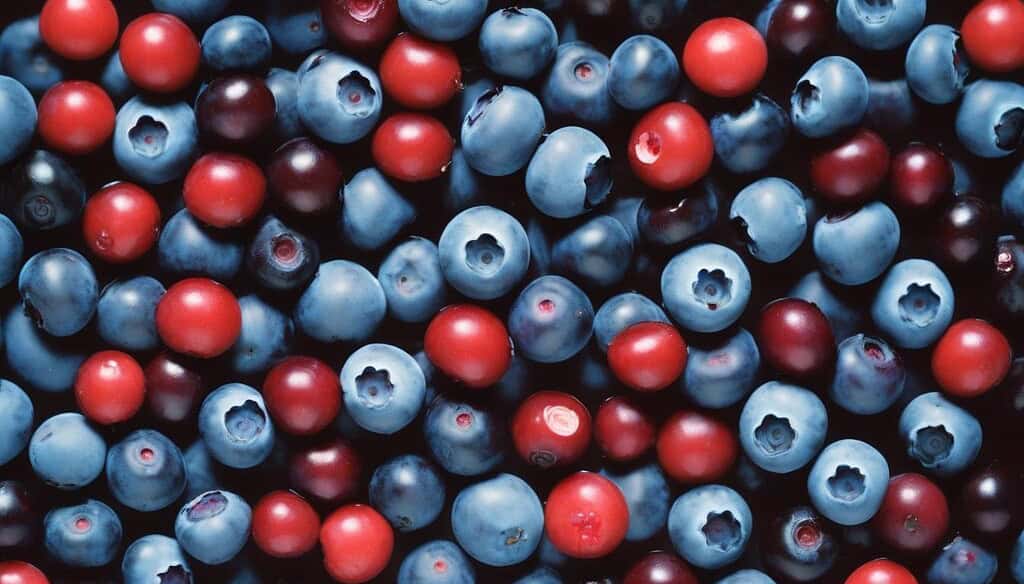
The heath family thrives in acidic soils where few other plants survive. Blueberries, cranberries, and lingonberries evolved unique antioxidant systems to handle harsh growing conditions. These same compounds provide remarkable health benefits when consumed by humans.
Blueberries concentrate more anthocyanins than almost any other common fruit. These purple pigments cross the blood-brain barrier and accumulate in brain regions associated with memory and learning. Regular blueberry consumption correlates with improved cognitive function in aging populations.
Cranberries developed their intense tartness as a natural preservation against bacterial infection. The proanthocyanidins in cranberries prevent harmful bacteria from adhering to urinary tract walls. This mechanism explains cranberries’ traditional use for preventing urinary infections.
Wild berries generally contain higher antioxidant concentrations than cultivated varieties. The stress of surviving in natural environments triggers plants to produce more protective compounds. These wild Fruit Families offer superior nutritional density despite smaller sizes.
The low sugar content of the heath family berries makes them suitable for blood sugar management. Their fiber and antioxidants slow sugar absorption while providing satiety. This combination supports steady energy levels without dramatic blood glucose spikes.
Antioxidant and Cognitive Support Compounds in Ericaceae Fruits per 100g
| Heath Family Berry | Anthocyanins (mg) | Proanthocyanidins (mg) | ORAC Value | Cognitive Benefits |
|---|---|---|---|---|
| Wild Blueberry | 487 | 179 | 9621 | Memory enhancement |
| Cultivated Blueberry | 163 | 52 | 4669 | Learning support |
| Cranberry | 67 | 418 | 9090 | Neuroprotection |
| Lingonberry | 84 | 89 | 7842 | Focus improvement |
| Bilberry | 558 | 267 | 7570 | Vision support |
8. Fruit Families: Solanaceae (Nightshade Family) And Their Surprising Benefits

The nightshade family faced suspicion for centuries due to toxic relatives like deadly nightshade. However, edible members like tomatoes, peppers, and goji berries provide exceptional nutrition. Understanding these Fruit Families requires separating fact from historical fear.
Tomatoes originated in South America, where indigenous peoples cultivated them for over 2,000 years. European colonizers initially avoided tomatoes due to nightshade family associations. This hesitation delayed recognition of tomato’s remarkable lycopene content and cardiovascular benefits.
Bell peppers contain more vitamin C than most citrus fruits. Their colorful varieties indicate different antioxidant profiles, with red peppers offering the highest concentrations. The capsaicin in hot peppers provides anti-inflammatory and metabolic benefits beyond their culinary heat.
Goji berries contain concentrated nutrients that help them survive harsh Himalayan conditions. These small fruits pack zeaxanthin, beta-carotene, and unique polysaccharides that support immune function. Traditional Chinese medicine valued goji berries for longevity and vitality enhancement.
Modern research validates many traditional uses of nightshade family foods. Their alkaloid compounds, once feared as toxins, often provide therapeutic benefits in appropriate doses. This demonstrates how scientific understanding can overcome historical misconceptions.
Vitamin and Antioxidant Content of Edible Nightshade Fruits per 100g
| Nightshade Fruit | Lycopene (mg) | Vitamin C (mg) | Capsaicin (mg) | Zeaxanthin (μg) |
|---|---|---|---|---|
| Red Tomato | 2.6 | 14 | 0 | 123 |
| Red Bell Pepper | 0 | 128 | 0 | 208 |
| Jalapeño Pepper | 0 | 118 | 25 | 534 |
| Goji Berry | 0 | 48 | 0 | 2454 |
| Tomatillo | 0.1 | 12 | 0 | 67 |
Conclusion: Fruit Families and Their Wellness Secrets
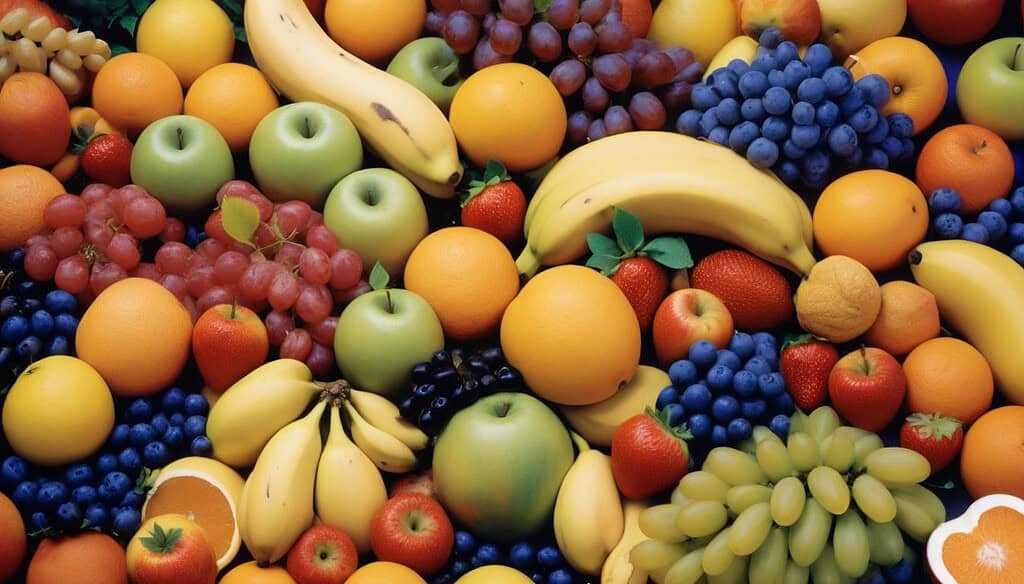
These eight Fruit Families represent millions of years of evolutionary refinement that created perfect partnerships with human nutrition. Each family developed unique strategies for survival that translate into specific health benefits for modern consumers.
The diversity within Fruit Families provides natural insurance against nutritional deficiencies. Rotating between different families ensures exposure to complementary compounds that work synergistically in human metabolism. This variety principle guided traditional diets across all cultures.
Climate change threatens many wild relatives of the common Fruit Families. Preserving genetic diversity becomes crucial for maintaining nutritional security as environmental conditions shift. Ancient varieties often contain superior nutrient profiles compared to modern commercial cultivars.
Understanding botanical relationships helps consumers make informed dietary choices. Foods from the same family often share similar benefits, allowing substitutions based on availability, season, or personal preference. This knowledge empowers people to optimize their nutritional intake.
The future of human nutrition depends on protecting and promoting diverse fruits. Supporting small-scale growers who maintain heritage varieties preserves both genetic resources and traditional knowledge. These efforts ensure that future generations inherit the full spectrum of nature’s nutritional wisdom.
Global Health Impact and Future Sustainability of Major Fruit Families
| Fruit Family | Primary Health Benefits | Genetic Varieties | Climate Vulnerability | Conservation Priority |
|---|---|---|---|---|
| Rutaceae | Immune system support | 1600+ | Moderate | High |
| Vitaceae | Cardiovascular health | 8000+ | Low | Medium |
| Rosaceae | Digestive wellness | 4000+ | High | Critical |
| Musaceae | Muscle function | 500+ | Very High | Critical |
| Anacardiaceae | Energy metabolism | 700+ | Moderate | High |
| Cucurbitaceae | Hydration balance | 950+ | High | High |
| Ericaceae | Cognitive function | 450+ | Low | Medium |
| Solanaceae | Antioxidant protection | 3000+ | Moderate | High |

